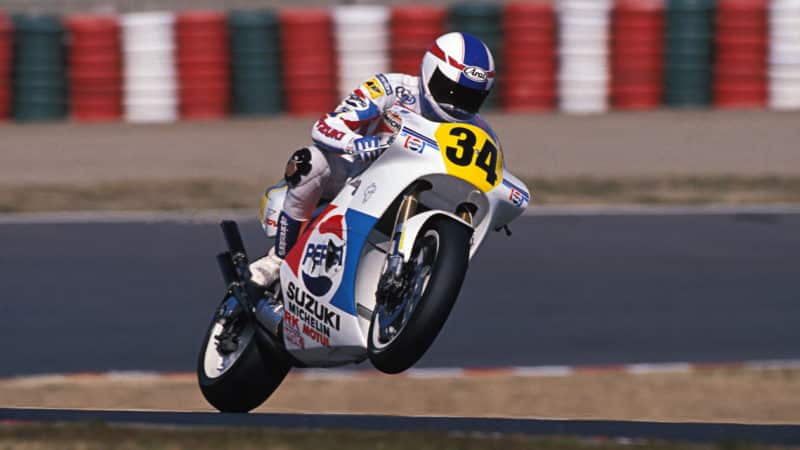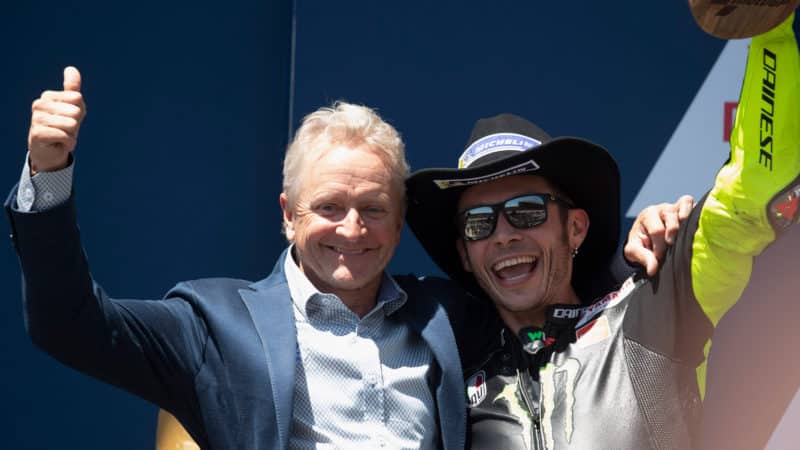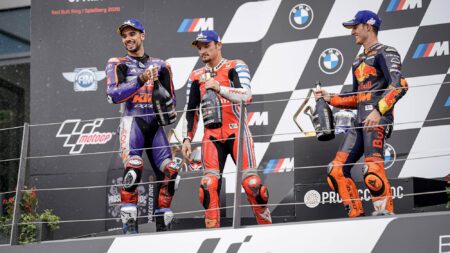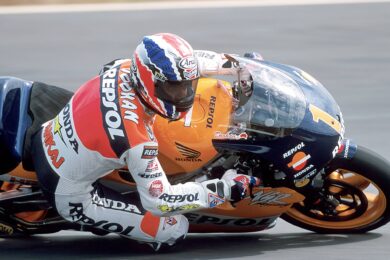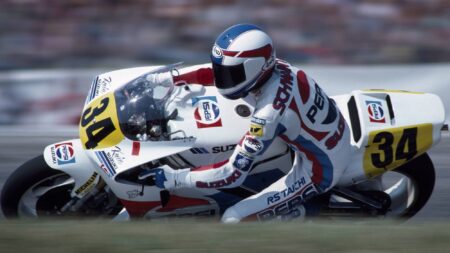Modern-day riding position seems to be really different with all the electronics – they can get way off the bike to get around the centre of the corner better. You couldn’t do that on a 500 because as soon as you cracked the throttle it would’ve sent you to the moon.
I’d try to get myself into that neutral position, so I’d got the bike transitioning into the corner, but once I’m there I’ve got to get back on top of the thing, ready for it to start spinning. I’ve got to get some weight on the outside ’peg, because if I don’t it’s just going to spin and go nowhere.
Presumably you also used wheelspin to turn the bike?
Absolutely. I’d probably use spin more to help turn the bike if I hadn’t got it set up right so I couldn’t roll through the centre of the corner as fast as I wanted.
As the championship year [1993] came to fruition the bike started working better and we were closer on bike set-up, plus maybe I started learning how to ride a bike a little differently. Instead of having to steer the bike with some spin to get off the turn I tried to use a little more corner speed and save the tyre by getting it to drive off the corner better.
But absolutely, when you were in a pinch because you’d gone into the corner to get underneath somebody, so maybe you’d used a tighter entrance and you weren’t able to shape the apex like you needed to, then yeah, definitely use some spin and get off the inside of the bike a bit more because you could weight the inside ’peg and help the thing to spin.
You could definitely cause the bike to spin more and you’d do that if you were, like, I need to tighten up the exit because if I don’t I’m gonna be on the kerb, which in my days were crazy slippery. Don’t ever touch the paint! Not ever!
When your new crew chief Stuart Shenton arrived in 1992, did that help you ride with more corner speed?
Absolutely, though it could also have been the transition of my riding style, from what it was when I got on a grand prix bike in ’88 to where I ended up in ’93 and ’94.
Maybe I got a bit smarter – hey, this makes my life a whole lot easier because I’m not having to kill everything on the brakes, because I can get off the corner and drive down the straightaway with those guys.
“I used to squeeze the brake as hard as I could instantly — yaaah!”
If the Suzuki wasn’t completely sideways and hung out of shape my top speed wasn’t all that bad. In ’93 the bike wasn’t quite that last mile an hour as fast as the Honda but at most places it was right there with the Yamaha, except maybe those times when we didn’t quite get the jetting exactly right so the motor wouldn’t run at the top like it needed to
What was your corner-entry technique – front and rear brakes while shifting down?
I never touched the rear brake. I only ever touched the rear once I got in trouble somewhere, which usually caused more trouble.
I can tell you the three times I used the rear brake other than that. Well, I don’t remember the other two but the first turn at Phillip Island was the classic. I was trying to chase down [Wayne] Gardner [in 1990] on the last lap when I crashed at the first turn: oh shit, I’m in a little too deep, so I just want to feather the rear brake. So I touched the brake and yaaak, I was down. My boys had put in new brake pads before the race!
The front brake, I remember it like it was yesterday – I used to squeeze the brake as hard as I could instantly. I never let the load transition to the front and then bury the brakes, it was squeeze them as hard as I could from the first time I touched the lever – yaaah!
I’d transition as hard onto the brakes as I could and then if I hadn’t quite got the thing square in line for the corner, or if I put it in there so the bike got out of shape, I’d just use the clutch to help to settle the thing down.
You were a demon on the brakes – see god, then brake and all that – was that just sheer aggression and holding on for dear life?
That was such a challenge for the engineers, to get a bike that would transition off the brakes. They’d say to me, you’re not giving the thing a chance to transition because you’re absolutely burying the thing on the front brake.
I remember the race at Suzuka in ’91 – it’s what I call my best race ever.

